It's undeniable that Slayer are the founding fathers of thrash metal, and play an integral part in the history of heavy metal as a whole. Over the course of more than three decades, the band created some of the most influential songs and laid the groundwork for countless bands to come. Since their 1981 formation, the band have created a dozen records, sold millions of albums, gained a legion of diehard fans (some going as far as carving their logo into their skin) and sparked controversy every step of the way.
Along with other pioneers of thrash metal such as Metallica, Megadeth and Exodus, Slayer introduced the world to a heavier approach to heavy metal. The band took inspiration from acts like Mercyful Fate, Venom and Iron Maiden, but unlike their peers, Slayer pushed their music to be as heavy, dark and evil as they possibly could. Lyrics about Nazi human experiments, serial killers and praising Satan, along with their furiously chaotic instrumentation, inspired new extreme metal genres like death and black metal, but also landed the band in hot water.
In 1996, a lawsuit (which was eventually dropped) was brought against Slayer for allegedly inspiring three men to drug, murder and rape a young woman. The band have also faced numerous accusations of being Nazi sympathizers for their eagle logo's resemblance to Nazi imagery and lyrical themes, especially their cover of Minor Threat's "Guilty of Being White," where they changed the lyrics to "guilty of being right."
The band have always defended themselves by saying their intentions were to scare people, but some controversies have been beyond their control, such as releasing their ninth studio album, God Hates Us All, on September 11, 2001. (Mariah Carey's Glitter was released on the same day; she didn't get the same flak.)
After 35 years of reigning supreme over the heavy metal landscape, the iconic thrash metal band are embarking on their final world tour this year. In honour of their colossal contribution to music, we're digging deeper into their lengthy discography. Take a look below for Exclaim!'s Essential Guide to the kings of thrash metal, Slayer.
Essential Albums:
5. Hell Awaits
(1995)
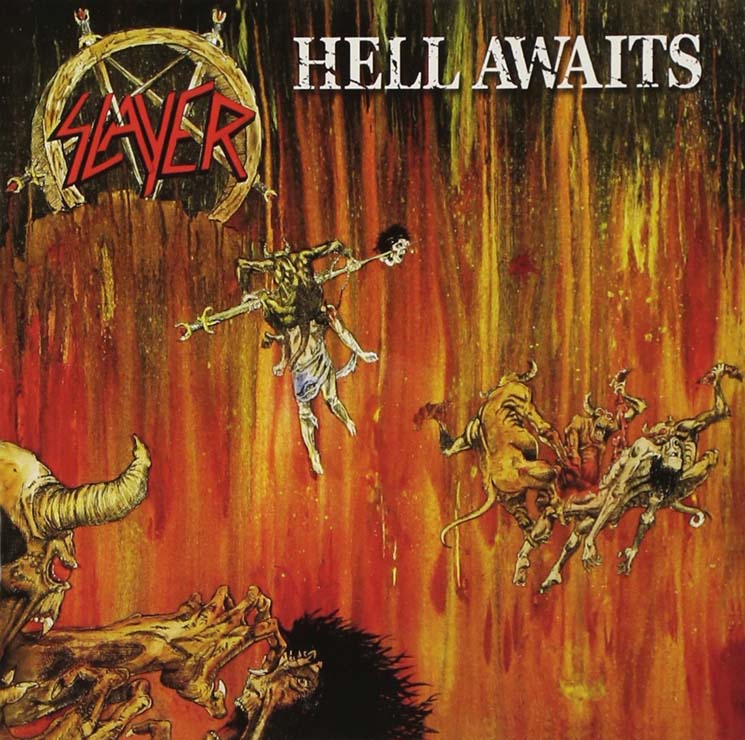
After releasing their Mercyful Fate-worshipping debut, Show No Mercy, Slayer established the iconic extreme thrash sound that would define generations of metal on Hell Awaits. The album shocked the public with a previously unheard level of chaotic, violent intensity.
The band introduced the album with a backwards recording of a demonic voice saying "join us" on the title track, before launching into a sludgy groove that ends in rapid drum work, wild solos and fierce vocals. The record is raw, yet ahead of its time, laying the groundwork for the band's iconic sound. Tracks such as "At Dawn They Sleep," "Necrophiliac" and "Praise of Death" are classic examples of how the band influenced early death and black metal. Hell Awaits offers a glimpse into the early formations of extreme music and Slayer's legacy.
4. Divine Intervention
(1994)

Although the record is contentious for being the first album without original drummer Dave Lombardo, Divine Intervention is one of the band's finest moments. Slayer had taken a slower approach than normal for a couple records prior to releasing Divine Intervention, so with a fresh face in the band, they opted to make a return to full-bore thrash metal. The album's serial killer-inspired lyrics, focusing specifically on Jeffrey Dahmer and Nazi official Reinhard Heydrich, lent a menacing atmosphere to their reinvigorated sound.
Divine Intervention was a turning point in production quality for Slayer, ushering in a much tighter, clean style, compared to the raw sound of their earlier works. Drummer Paul Bostaph incorporated a machine-like drumming style and reinvigorated the raging energy the band had stepped away from for nearly a decade.
3. God Hates Us All
(2001)
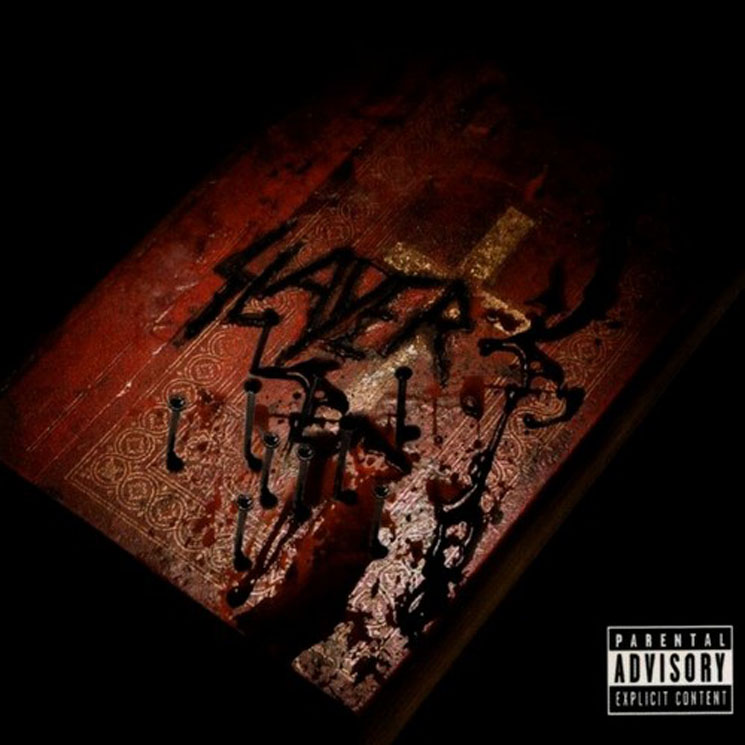
You can't get much more controversial than naming your album God Hates Us All. Slayer's ninth studio release was as anti-religion as it gets, with an album cover depicting a bloody bible with nails inserted in the shape of a pentagram, violently deviant lyrics and a horrifying case of bad timing with the release date.
God Hates Us All stands as Slayer's heaviest record. From the overt use of the album's title in the chorus of "Disciple," to the deep chugs on "New Faith" and the full-bore assault on "War Zone," the record has the best parts of Slayer pushed to their hardest levels.
2. Seasons in the Abyss
(1990)
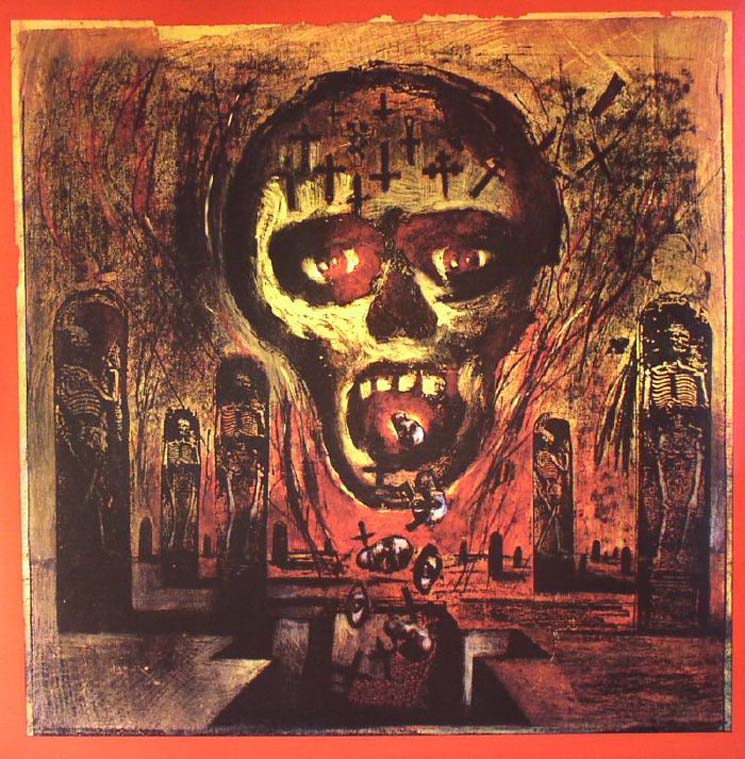
Seasons in the Abyss came at the tail end of Slayer's trilogy of major label releases with their original lineup. The band managed to strike a perfect middle ground between the ultra-fast pace of Reign In Blood and the mid-tempo heaviness of South of Heaven to create their most balanced album.
Tracks such as "War Ensemble" and "Hallowed Point" brought the blazing speeds that gained the band major attention, while "Spirit In Black" and "Blood Red" offered some solid mid-tempo thrash. Using their entire arsenal of tricks across the record, the band dropped some seriously heavy drawn-out grooves on the title track and "Dead Skin Mask," blending every element a Slayer fan could want into a single record.
1. Reign In Blood
(1986)
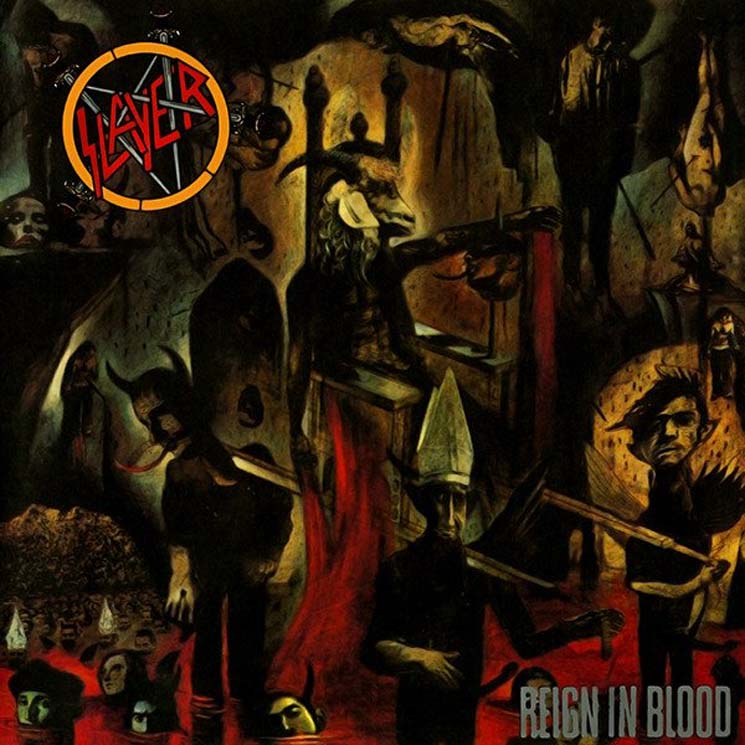
One of the most monumental albums in the entire history of metal, Reign In Blood is an unrelenting force that set the bar for what it means to be heavy. Clocking in at a mere 29 minutes, the record allows no time to breathe between the mind-melting solos, pulverizing drums and intense shrieks. Leaving no fat to trim, the band drop riffs and move on to the next the moment they have one established.
Songs like "Angel Of Death," "Raining Blood" and "Jesus Saves" show why Slayer were the most dangerous band in metal for a long time, bringing an intensity that changed the entire direction of the genre. The band managed to close the gap between hardcore punk and thrash metal by playing faster than any other band around. If you're searching for the pure nature of Slayer, Reign In Blood reigns over all.
What to Avoid:
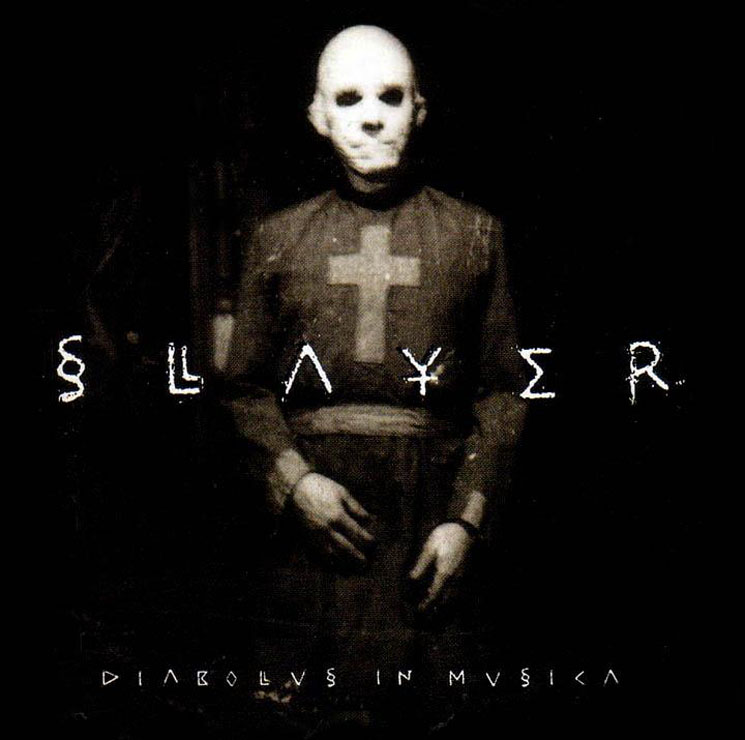
There aren't many bad Slayer albums, but when they fall flat, they fall hard. During the peak of the nu metal craze in the '90s, Slayer decided to experiment with their sound on Diabolus In Musica, and although it isn't a full-on nu metal record, there are elements of it throughout. Their heavy use of groove and strange vocal effects made for an embarrassing try at fitting into what the current cool was, and stands as the most obvious sore spot in their discography.
Slayer have taken many opportunities over the years to cover different bands, with very mixed results. If you're looking to dive into the bands who influenced Slayer's chaotically speedy side, 1996's Undisputed Attitude has everything you need, with a collection of covers of bands like Verbal Abuse, D.R.I., Minor Threat and the Stooges. Beyond that, the band's covers are awful.
The band put together a laughable cover of Iron Butterfly's "In-A-Gadda-Da-Vida" for the Less Than Zero soundtrack, which producer Rick Rubin pressured them into doing. They've described it themselves as "a poor representation of Slayer" and "a hunk of shit." They even took the time to cover Steppenwolf's "Born To Be Wild" for a Nascar soundtrack, which came off just as cheesy as one would expect. The metal legends also paid homage to the original masters of metal, Black Sabbath, with their take on "Hand of Doom," and while it isn't their worst cover attempt, it's probably one of the most boring Sabbath covers ever made.
Sadly, the band's final album, 2015's Repentless, is another rough release for Slayer. After the passing of guitarist Jeff Hanneman, the band seemed to haphazardly put together their last release. The record isn't completely unlistenable, but it is an unnecessary addition to their catalogue and doesn't stand out as anything more than filler material.
Further Listening:
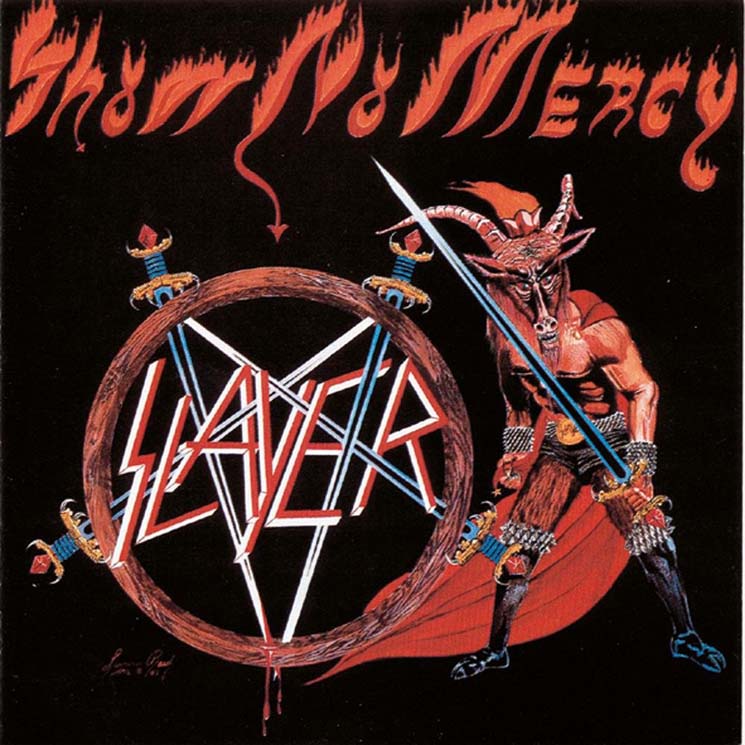
While Slayer are known as the kings of thrash metal, they started their career with a more melodic approach than what is usually expected from them. Their 1983 debut, Show No Mercy, is a fantastic look at how the band's early influences shaped their sound and led them to create a more extreme side of thrash metal.
Fans looking for more of the band's raw early material would do well to check out their 1984 EP Haunting the Chapel, which marked Slayer's first use of double-kick drumming.
Although it is overshadowed and stuffed between Slayer's career-defining albums Reign In Blood and Seasons In the Abyss, 1988's South of Heaven features some undeniably crucial Slayer tracks such as "Silent Scream," "South of Heaven" or "Ghosts of War." The band purposefully slowed their tempo after creating the ultra-fast Reign, without losing a shred of heaviness in the process.
After leaving the group for the majority of the '90s, Slayer reunited with Lombardo at the very end of 2001, and five years later, released Christ Illusion, their first album with every original member since Seasons. The band built on the success they found with God Hates Us All and managed to find a solid middle ground between their old and new approaches.
World Painted Blood, in 2009, continued in the same vein as Christ Illusion and was the last recording to feature Hanneman's guitar playing as well as Lombardo's drumming. By this point, the band had mastered how to create a Slayer album and could mercilessly shred away uninhibited without worrying of how they would be perceived.
Along with other pioneers of thrash metal such as Metallica, Megadeth and Exodus, Slayer introduced the world to a heavier approach to heavy metal. The band took inspiration from acts like Mercyful Fate, Venom and Iron Maiden, but unlike their peers, Slayer pushed their music to be as heavy, dark and evil as they possibly could. Lyrics about Nazi human experiments, serial killers and praising Satan, along with their furiously chaotic instrumentation, inspired new extreme metal genres like death and black metal, but also landed the band in hot water.
In 1996, a lawsuit (which was eventually dropped) was brought against Slayer for allegedly inspiring three men to drug, murder and rape a young woman. The band have also faced numerous accusations of being Nazi sympathizers for their eagle logo's resemblance to Nazi imagery and lyrical themes, especially their cover of Minor Threat's "Guilty of Being White," where they changed the lyrics to "guilty of being right."
The band have always defended themselves by saying their intentions were to scare people, but some controversies have been beyond their control, such as releasing their ninth studio album, God Hates Us All, on September 11, 2001. (Mariah Carey's Glitter was released on the same day; she didn't get the same flak.)
After 35 years of reigning supreme over the heavy metal landscape, the iconic thrash metal band are embarking on their final world tour this year. In honour of their colossal contribution to music, we're digging deeper into their lengthy discography. Take a look below for Exclaim!'s Essential Guide to the kings of thrash metal, Slayer.
Essential Albums:
5. Hell Awaits
(1995)

After releasing their Mercyful Fate-worshipping debut, Show No Mercy, Slayer established the iconic extreme thrash sound that would define generations of metal on Hell Awaits. The album shocked the public with a previously unheard level of chaotic, violent intensity.
The band introduced the album with a backwards recording of a demonic voice saying "join us" on the title track, before launching into a sludgy groove that ends in rapid drum work, wild solos and fierce vocals. The record is raw, yet ahead of its time, laying the groundwork for the band's iconic sound. Tracks such as "At Dawn They Sleep," "Necrophiliac" and "Praise of Death" are classic examples of how the band influenced early death and black metal. Hell Awaits offers a glimpse into the early formations of extreme music and Slayer's legacy.
4. Divine Intervention
(1994)

Although the record is contentious for being the first album without original drummer Dave Lombardo, Divine Intervention is one of the band's finest moments. Slayer had taken a slower approach than normal for a couple records prior to releasing Divine Intervention, so with a fresh face in the band, they opted to make a return to full-bore thrash metal. The album's serial killer-inspired lyrics, focusing specifically on Jeffrey Dahmer and Nazi official Reinhard Heydrich, lent a menacing atmosphere to their reinvigorated sound.
Divine Intervention was a turning point in production quality for Slayer, ushering in a much tighter, clean style, compared to the raw sound of their earlier works. Drummer Paul Bostaph incorporated a machine-like drumming style and reinvigorated the raging energy the band had stepped away from for nearly a decade.
3. God Hates Us All
(2001)

You can't get much more controversial than naming your album God Hates Us All. Slayer's ninth studio release was as anti-religion as it gets, with an album cover depicting a bloody bible with nails inserted in the shape of a pentagram, violently deviant lyrics and a horrifying case of bad timing with the release date.
God Hates Us All stands as Slayer's heaviest record. From the overt use of the album's title in the chorus of "Disciple," to the deep chugs on "New Faith" and the full-bore assault on "War Zone," the record has the best parts of Slayer pushed to their hardest levels.
2. Seasons in the Abyss
(1990)

Seasons in the Abyss came at the tail end of Slayer's trilogy of major label releases with their original lineup. The band managed to strike a perfect middle ground between the ultra-fast pace of Reign In Blood and the mid-tempo heaviness of South of Heaven to create their most balanced album.
Tracks such as "War Ensemble" and "Hallowed Point" brought the blazing speeds that gained the band major attention, while "Spirit In Black" and "Blood Red" offered some solid mid-tempo thrash. Using their entire arsenal of tricks across the record, the band dropped some seriously heavy drawn-out grooves on the title track and "Dead Skin Mask," blending every element a Slayer fan could want into a single record.
1. Reign In Blood
(1986)

One of the most monumental albums in the entire history of metal, Reign In Blood is an unrelenting force that set the bar for what it means to be heavy. Clocking in at a mere 29 minutes, the record allows no time to breathe between the mind-melting solos, pulverizing drums and intense shrieks. Leaving no fat to trim, the band drop riffs and move on to the next the moment they have one established.
Songs like "Angel Of Death," "Raining Blood" and "Jesus Saves" show why Slayer were the most dangerous band in metal for a long time, bringing an intensity that changed the entire direction of the genre. The band managed to close the gap between hardcore punk and thrash metal by playing faster than any other band around. If you're searching for the pure nature of Slayer, Reign In Blood reigns over all.
What to Avoid:

There aren't many bad Slayer albums, but when they fall flat, they fall hard. During the peak of the nu metal craze in the '90s, Slayer decided to experiment with their sound on Diabolus In Musica, and although it isn't a full-on nu metal record, there are elements of it throughout. Their heavy use of groove and strange vocal effects made for an embarrassing try at fitting into what the current cool was, and stands as the most obvious sore spot in their discography.
Slayer have taken many opportunities over the years to cover different bands, with very mixed results. If you're looking to dive into the bands who influenced Slayer's chaotically speedy side, 1996's Undisputed Attitude has everything you need, with a collection of covers of bands like Verbal Abuse, D.R.I., Minor Threat and the Stooges. Beyond that, the band's covers are awful.
The band put together a laughable cover of Iron Butterfly's "In-A-Gadda-Da-Vida" for the Less Than Zero soundtrack, which producer Rick Rubin pressured them into doing. They've described it themselves as "a poor representation of Slayer" and "a hunk of shit." They even took the time to cover Steppenwolf's "Born To Be Wild" for a Nascar soundtrack, which came off just as cheesy as one would expect. The metal legends also paid homage to the original masters of metal, Black Sabbath, with their take on "Hand of Doom," and while it isn't their worst cover attempt, it's probably one of the most boring Sabbath covers ever made.
Sadly, the band's final album, 2015's Repentless, is another rough release for Slayer. After the passing of guitarist Jeff Hanneman, the band seemed to haphazardly put together their last release. The record isn't completely unlistenable, but it is an unnecessary addition to their catalogue and doesn't stand out as anything more than filler material.
Further Listening:

While Slayer are known as the kings of thrash metal, they started their career with a more melodic approach than what is usually expected from them. Their 1983 debut, Show No Mercy, is a fantastic look at how the band's early influences shaped their sound and led them to create a more extreme side of thrash metal.
Fans looking for more of the band's raw early material would do well to check out their 1984 EP Haunting the Chapel, which marked Slayer's first use of double-kick drumming.
Although it is overshadowed and stuffed between Slayer's career-defining albums Reign In Blood and Seasons In the Abyss, 1988's South of Heaven features some undeniably crucial Slayer tracks such as "Silent Scream," "South of Heaven" or "Ghosts of War." The band purposefully slowed their tempo after creating the ultra-fast Reign, without losing a shred of heaviness in the process.
After leaving the group for the majority of the '90s, Slayer reunited with Lombardo at the very end of 2001, and five years later, released Christ Illusion, their first album with every original member since Seasons. The band built on the success they found with God Hates Us All and managed to find a solid middle ground between their old and new approaches.
World Painted Blood, in 2009, continued in the same vein as Christ Illusion and was the last recording to feature Hanneman's guitar playing as well as Lombardo's drumming. By this point, the band had mastered how to create a Slayer album and could mercilessly shred away uninhibited without worrying of how they would be perceived.




